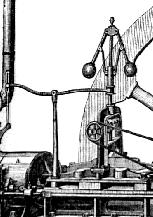
Soho, Birmingham.
The Boulton & Watt machine-shop.

The watt governor
Watt built a first engine model and decided that the steam would to go in the cylinder above the piston. The cylinder was closed with a cap with a stuffing box for the rod to pass through.
The steam helped atmospheric pressure to drive the piston down.
In 1769 Watt sought and obtained a patent for a "new method for lessening the consumption of steam and fuel in fire engines". When Watt gained support for developing his engine from the great Birmingham manufacturer, Matthew Boulton, he started manufacturing engines.
In 1776, he built an engine with a cylinder of 127 cm diameter to pump water at Bloomfield Colliery. In the same year Wilkinson, iron master, built a new type of lathe.
This lathe made possible to bore a cylinder with a precision which had never before been seen.
The final version of the new Watt engine (please see the animation) worked in 1778.
In 1782 Watt made his double-acting engine (please see the animation). With this improvement the engine had double the power with the same displacement. To further save coal, the steam was admitted inside the cylinder for a fraction of the stroke which continued by steam expansion. Watt never developped engines that were powerful for their weight, because he refused to use high-pressure steam. He feared that could not make the boiler and engine strong enough to withstand such pressure with the iron and workmanship of the time. He did, however, make minor improvements, such as the steam governor that now is named "Watt's governor".